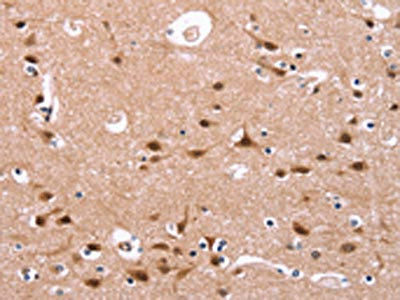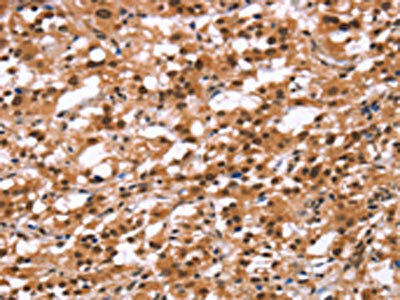Description
| Antibody Name: | HIPK1 Antibody (PACO19758) |
| Antibody SKU: | PACO19758 |
| Size: | 50ul |
| Host Species: | Rabbit |
| Tested Applications: | ELISA, IHC |
| Recommended Dilutions: | ELISA:1:1000-1:2000, IHC:1:25-1:100 |
| Species Reactivity: | Human, Mouse, Rat |
| Immunogen: | Synthetic peptide of human HIPK1 |
| Form: | Liquid |
| Storage Buffer: | -20°C, pH7.4 PBS, 0.05% NaN3, 40% Glycerol |
| Purification Method: | Antigen affinity purification |
| Clonality: | Polyclonal |
| Isotype: | IgG |
| Conjugate: | Non-conjugated |
 | The image on the left is immunohistochemistry of paraffin-embedded Human brain tissue using PACO19758(HIPK1 Antibody) at dilution 1/25, on the right is treated with synthetic peptide. (Original magnification: x200). |
 | The image on the left is immunohistochemistry of paraffin-embedded Human thyroid cancer tissue using PACO19758(HIPK1 Antibody) at dilution 1/25, on the right is treated with synthetic peptide. (Original magnification: x200). |
| Background: | The protein encoded by this gene belongs to the Ser/Thr family of protein kinases and HIPK subfamily. It phosphorylates homeodomain transcription factors and may also function as a co-repressor for homeodomain transcription factors. Alternative splicing results in four transcript variants encoding four distinct isoforms. |
| Synonyms: | homeodomain interacting protein kinase 1 |
| UniProt Protein Function: | HIPK1: homeodomain interacting protein kinase 1 is a CMGC kinase of the DYRK family. May play a role as a corepressor for homeodomain transcription factors. Phosphorylates DAXX in response to stress, and mediates its translocation from the nucleus to the cytoplasm. Expression elevated in many breast cancer cell lines. Null mice are resistant to carcinogens. Binds the p53 tumor suppressor. 4 alternatively spliced isoforms of the human protein have been described.Protein type: Kinase, protein; Protein kinase, CMGC; Protein kinase, Ser/Thr (non-receptor); EC 2.7.11.1; CMGC group; DYRK family; HIPK subfamilyChromosomal Location of Human Ortholog: 1p13.2Cellular Component: cytoplasm; nucleoplasm; nucleusMolecular Function: protein bindingBiological Process: eye development; positive regulation of angiogenesis |
| UniProt Protein Details: | |
| NCBI Summary: | The protein encoded by this gene belongs to the Ser/Thr family of protein kinases and HIPK subfamily. It phosphorylates homeodomain transcription factors and may also function as a co-repressor for homeodomain transcription factors. Alternative splicing results in four transcript variants encoding four distinct isoforms. [provided by RefSeq, Jul 2008] |
| UniProt Code: | Q86Z02 |
| NCBI GenInfo Identifier: | 34395641 |
| NCBI Gene ID: | 204851 |
| NCBI Accession: | Q86Z02.1 |
| UniProt Secondary Accession: | Q86Z02,O75125, Q5SQL2, Q5SQL4, Q5SQL5, Q8IYD7, Q8NDN5 Q8NEB6, Q8TBZ1, A6NJ34 |
| UniProt Related Accession: | Q86Z02 |
| Molecular Weight: | 87,302 Da |
| NCBI Full Name: | Homeodomain-interacting protein kinase 1 |
| NCBI Synonym Full Names: | homeodomain interacting protein kinase 1 |
| NCBI Official Symbol: | HIPK1 |
| NCBI Official Synonym Symbols: | Myak; Nbak2 |
| NCBI Protein Information: | homeodomain-interacting protein kinase 1 |
| UniProt Protein Name: | Homeodomain-interacting protein kinase 1 |
| UniProt Synonym Protein Names: | Nuclear body-associated kinase 2 |
| Protein Family: | |
| UniProt Gene Name: | HIPK1 |
| UniProt Entry Name: | HIPK1_HUMAN |






